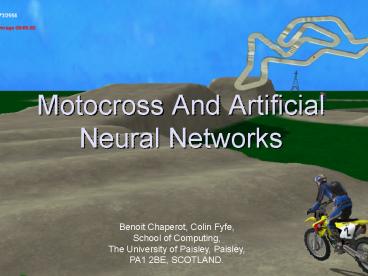Motocross And Artificial Neural Networks - PowerPoint PPT Presentation
1 / 11
Title:
Motocross And Artificial Neural Networks
Description:
ANN trained using BP performance improved using bagging and boosting techniques. Video ... Further use of bagging techniques. Use of swarm intelligence techniques ... – PowerPoint PPT presentation
Number of Views:52
Avg rating:3.0/5.0
Title: Motocross And Artificial Neural Networks
1
Motocross And Artificial Neural Networks
Benoit Chaperot, Colin Fyfe, School of
Computing, The University of Paisley, Paisley,
PA1 2BE, SCOTLAND.
2
Why use Artificial Neural Network
- Riding a motorbike involves behaviours which are
difficult to express as a set of procedural rules - ANN expected to behave in a human or animal-like
manner - Capable of extrapolating when presented with new
and different sets of inputs - Capable of evolving
3
The ANN
- The inputs
- Bike position, orientation and velocity relative
to the track - Terrain height information
- Track path information
The outputs Accelerate, brake Turn left,
right Lean forward, backward
ANN
4
Two forms of training
- Evolutionary algorithms Training considered as
an optimisation to be performed using genetic
algorithms - Back propagation algorithm ANNs are trained
using training data made from a recording of the
game being played by a good human player
5
Evolutionary Algorithm
- Training considered as optimisation
- ANNs initialised with random weights
- 80 ANNs per generation
- Each ANN evaluated for 60 seconds or less using a
score function - Fittest ANNs are given more chance to reproduce
- The whole population converges to a satisfactory
solutions to the problem after approximately 100
generations - May be difficult to find a good evaluation
function
6
Fitness Function
- Bonus for passing through a way point
- Bonus/penalty (i.e. normally negative) for
missing a way point - Bonus/penalty (i.e. normally negative) for
crashing - Bonus/penalty (i.e. normally negative) for every
meter away from the centre of the next way point
7
Back propagation algorithm
- Training data made by the main author playing the
game on many different tracks. - Each sample of training data contains a situation
(bike position, orientation on a track) and the
main authors solution to the situation - Training data composed of approximately 120000
samples - Good solution to the problem after only 20000
iterations
8
Results
- ANNs learn and perform like a human intelligence
- Average lap time
- Good human player 2 min 10 sec
- ANN trained using GA 2 min 50 sec
- ANN trained using BP 2 min 20 sec
- ANN trained using GA slow, but better than one
trained using BP at adapting to new situations - ANN trained using BP performance improved using
bagging and boosting techniques
9
Video
- Videod.avi
10
Bagging and Boosting
- Create N bags by randomly sampling from data set
with replacement - P(datum in bag) 0.67
- Machines trained on bags separately
- Results combined
- Boosting puts more emphasis on data which
machines trained on early bags find difficult - Anti-boosting seems to work well !
11
Future work
- Use evolutionary algorithms with a much larger
population size and number of generations - Further use of bagging techniques
- Use of swarm intelligence techniques











![Introduction to Artificial Neuron Networks [ANN] PowerPoint PPT Presentation](https://s3.amazonaws.com/images.powershow.com/6292342.th0.jpg?_=20150319091)



















